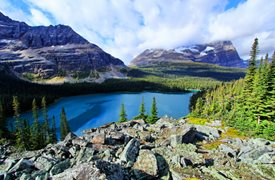
Canada’s breathtaking Rockies were almost inaccessible before the advent of the railway in 1884. For millions of years, the majestic shale peaks and pristine ice-fields of what today is Yoho National Park guarded a treasure trove of perfectly-preserved fossils: the remains of the planet’s first marine ecosystem. These fantastic creatures, now extinct, roamed the seafloor of the region, some half a billion years ago. It was not until 1909 that intrepid paleontologist Charles Doolittle Walcott made an initial discovery of fossils while doing fieldwork in the Rockies. He subsequently returned each season to explore deeper into the Burgess Shale, eventually unearthing a phenomenal 68,000 samples, before his death in 1927.
Walcott’s finds were particularly intriguing because they were the first discovery of soft-tissue fossils. In addition to the tangible remains of hard matter such as teeth, bones, and shells, the Burgess Shale fossils’ soft tissue — brains, heart, livers, and nerve networks — had been replaced by minerals, making it possible for paleontologists to create very detailed images of these prehistoric marine creatures.
Walcott was no amateur weekend scientist. The American specialist in Cambrian Trilobites and Brachiopods held prestigious positions as Director of the US Geological Society (1894-1907), Secretary of the Smithsonian Institute (1907-27) and also served as science advisor to President Theodore Roosevelt. Despite his commitments in Washington, Walcott rarely missed a season of fieldwork, his true passion. The Burgess Shale soft-tissue fossils represented whole groups of animals, completely new to science. Some were almost unbelievable, including the 5-eyed
Opabnia, which sported a long snout like a vacuum cleaner’s hose, and the
Hallucigenia, which Walcott deduced must have walked on bilateral symmetrical spines.
It was perhaps the sheer scale of the discovery that prevented Walcott’s discovery for being truly appreciated during his lifetime. His academic papers and 1911 article in
The National Geographic, “A Geologist’s Paradise” were well received in scholarly circles, but it would take another 40 years after Walcott’s death for the find to be truly appreciated for what it was, a major breakthrough in our understanding of what life on earth was like millions of years before the advent of mankind.
Yoho National Park is the smallest of Canada’s four contiguous national parks; an area designated a UNESCO World Heritage Site because of its scenic splendor and outstanding physical features. Visit this magnificent region on Alexander + Roberts’s new
Canada by Land, Water + Rail itinerary, always capped at just 16 guests for your maximum enjoyment. Speak to one of our knowledgeable reservation agents to learn more.